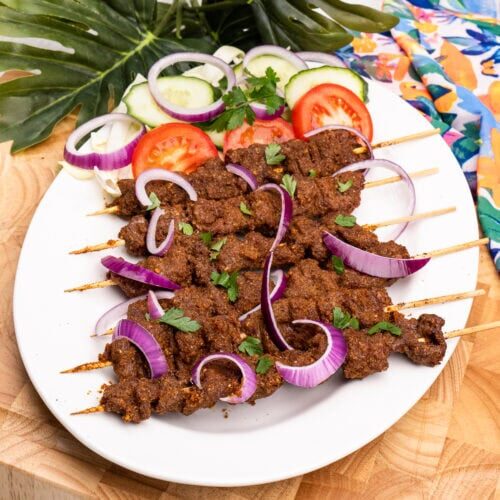If you’ve ever strolled down the lively streets of Lagos, Abuja, or Kano in the evening, you’ve probably caught the irresistible aroma of Suya—Nigeria’s famous spicy grilled meat. Skewered on sticks, coated in fiery Yaji spice, and grilled to smoky perfection, Suya isn’t just food. It’s an experience, a street-side ritual, and a piece of Nigerian culture that has traveled far beyond its borders.
But what if you’re craving that same authentic taste while living in Canada, the U.S., or anywhere else? While nothing quite compares to getting your Suya fresh from a roadside vendor, you can absolutely recreate this rich experience in your own kitchen.
This guide will walk you step-by-step through preparing the Suya spice blend (Yaji), choosing and marinating your meat, and grilling it to perfection. You’ll also discover practical tips for achieving that smoky flavor, even if you don’t have a charcoal grill.
What is Suya?
Suya is a traditional Nigerian street food that originated with the Hausa people of Northern Nigeria. It is most commonly made with beef or ram, though chicken, goat, or even fish can also be used.
What makes Suya truly unforgettable is its special spice blend known as Yaji. This dry rub combines ground roasted peanuts with bold spices like cayenne pepper, paprika, ginger, and garlic. The peanuts add a nutty depth that balances the heat, while the spices create layers of flavor that cling beautifully to thin cuts of meat. Suya is usually served hot, with slices of raw onions, tomatoes, and cabbage.
The beauty of Suya lies in its communal nature. Traditionally it is served wrapped in old newspaper or foil, meant to be eaten with your hands and shared among friends and family while chatting and laughing together. Suya vendors do not just sell food. They create little gathering spots where communities come alive.
There is no single “standard” recipe for Yaji. Every vendor has their own secret twist, with spice levels and flavors varying widely. That flexibility is what makes Suya so exciting to make at home because you can adjust it to your own taste and create your own signature blend.
Ingredients You’ll Need
Before we explore the method, here’s your Suya shopping list. Most of these ingredients are available in African or international grocery stores, and some you may already have in your pantry.
For the Yaji (Suya Spice Blend)
- 2 cups roasted peanuts (or 1 cup kuli-kuli if you have it)
- 2–3 tablespoons cayenne pepper or chili powder (adjust to your heat preference)
- 1 tablespoon dried ginger powder
- 1 tablespoon garlic powder
- 1 tablespoon paprika (adds smokiness and color)
- 1 bouillon cube, crushed
- 1 teaspoon salt (adjust to taste)
- ½ teaspoon black pepper
- ½ teaspoon ground cloves (optional, for a more authentic flavor)
- 1 tablespoon onion powder
For the Meat
- 1 ½ pounds (700g) beef sirloin, flank steak, or chicken breast
- 2–3 tablespoons vegetable oil (for basting)
- Bamboo skewers (soaked in water for 30 minutes to prevent burning)
For Serving
- Sliced onions, tomatoes, cucumbers, and cabbage
- Flatbread (optional)
- Foil or parchment paper (for authentic street-style wrapping)
Step 1: Make the Yaji (Suya Spice Blend)
The magic of Suya lies in the spice. Getting this right sets the stage for everything else.
- Prepare the peanuts: If you’re using raw peanuts, roast them lightly in a dry pan until golden brown. Remove the skins by rubbing them in a clean kitchen towel. Grind into a fine powder using a food processor or mortar and pestle. The texture should be dry, not oily.
- Mix the spices: Add cayenne, paprika, ginger, garlic, onion powder, bouillon cube, and salt. Combine until well blended.
- Sift for smoothness. Pass your spice blend through a fine mesh sieve to remove any large pieces and ensure a smooth, even texture.
- Store: Keep in an airtight container. The Yaji can last up to a month if stored in a cool, dry place.
Step 2: Preparing the Meat
Choosing the right cut is crucial. Go for lean but tender cuts like sirloin, flank, or tenderloin for beef. For chicken, boneless breasts or thighs work best.
- Slice thinly: Cut the meat into thin strips of about ¼ inch thick. Thin slices absorb flavor better and cook faster.
- Marinate: Place the strips in a bowl, drizzle lightly with oil, and coat generously with Yaji spice. Use your hands to massage the spice into every surface.
- Rest: Cover and let the meat marinate for at least 30 minutes. For a deeper flavor, leave it in the fridge for 2–4 hours.
Note: Don’t drown the meat in oil. A light drizzle helps the spice stick while allowing the grill to work its smoky magic.
Step 3: Grilling the Suya
Traditionally, Suya is cooked over open flames or a charcoal grill. But you can still achieve great results with a stovetop grill pan or oven broiler.
Charcoal Grill Method (Most Authentic)
- Preheat the grill until hot.
- Thread the marinated meat onto soaked skewers.
- Grill for 4–5 minutes on each side, basting occasionally with oil, until browned and slightly charred.
Oven Broiler Method (Indoor Option)
- Preheat oven to 450°F (230°C).
- Arrange skewers on a lined baking tray.
- Broil for 12–15 minutes, flipping halfway through.
Grill Pan/Stovetop
- Heat the pan until smoking.
- Lay skewers and grill for 3–4 minutes per side.
- Add a small pinch of smoked paprika if you want extra smokiness.
Note: Don’t overcrowd the grill or tray. Leaving space ensures even cooking and that signature char.
Step 4: Serving Suya the Authentic Way
The fun of Suya is in how it’s served. For a true Nigerian street food vibe:
- Place hot Suya skewers on foil or newspaper.
- Garnish with slices of raw onions, tomatoes, and cabbage.
- Wrap loosely and let the flavors mingle for a minute before digging in.
For a modern twist, you can serve Suya with:
- Flatbread or pita: Makes a Suya wrap.
- Rice or fries: Turns it into a hearty dinner.
- Party skewers: Bite-sized versions for entertaining guests.
Pair with a cold malt drink, beer, or even a chilled fruit juice.
Pro Tips for Perfect Suya at Home
- For Smoky Flavor Without Charcoal: Add a dash of smoked paprika or a drop of liquid smoke to your marinade.
- Adjust the Heat: Reduce cayenne for a milder spice level or increase it for fiery heat.
- Keep it Juicy: Don’t overcook. Suya tastes best when tender, not dry.
- Reuse Yaji Wisely: Sprinkle leftover Yaji on roasted potatoes, fish, or chicken wings.
Common Mistakes to Avoid
- Using Thick Meat Cuts: Thick slices take too long to cook and don’t absorb enough flavor.
- Skipping the Resting Time: The spice needs time to sink in; don’t rush it.
- Overloading with Oil: Too much oil prevents proper grilling and smokiness.
- Ignoring Food Safety: Always check that meat is cooked through, especially chicken.
- Not Soaking Skewers: Wooden skewers can burn if you skip this step.
Why Suya is More Than Just Food
Suya is deeply tied to Nigerian culture. It’s the go-to evening snack, the treat after a long day, and the food you share at roadside joints with friends. Making Suya at home is bringing a piece of that street culture into your kitchen.
When you bite into smoky, spicy, tender Suya, you’re tasting history, community, and a love for bold flavors that have stood the test of time.












